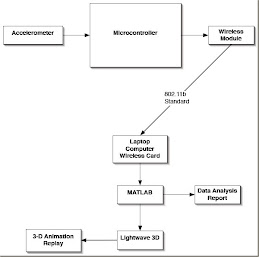
Here is a picture of the final product!





Status Report 2/12/09
We are well in the implementation phase of our project.
Materials to mount the accelerometer and microcontroller on the skateboard have been obtained. We are using an electrical box that can be screwed to the bottom of the skateboard.
Currently we have had success with getting the wireless system to work. The next step is to receive data from the accelerometer and transmit it over the wireless system. Once this data is recorded we can analyze it.
Using the trapezoidal rule we have been able to produce velocity data from the acceleration data. We are optimistic and excited with our progress. We are not sure if you ever found our website address. It can be found at skateacc.blogspot.com.
We have also purchased a base set of supplies to test the Zigbee wireless system that we are going to implement in the project. That includes an accelerometer, microcontroller, wireless adapter with the Zigbee module and an extra Zigbee module to be connected to the PC. We have had a few difficulties getting the Zigbee modules to communicate correctly, but are working on the issue. We are also working on how to encase the electrical parts of the system to protect them from abuse while we test the skateboard movements.
So currently we are on schedule of designing the system and will be into our Assembly portion as scheduled on the Gantt chart for the project.
Richard Larsen
Quinn Jackson
9/30/08
Status Report
The skateboard accelerometer project is well under way. In review, the project will use accelerometers attached to a skateboard to tract its movements. By doing so, we hope to develop software that can interpret this data and create a three dimensional image of the movements. Along with this three dimensional image, values of speed, jumping height and hang time will also be calculated.
The first step to this project is to research components to be used. We are looking for small accelerometer sensors that can easily be attached to a skateboard and easily protected. The accelerometers also need to be tri-axis to get the most accurate data. We have discovered that there is a need for two microcontrollers, one for the skateboard and one for the body. Each of the accelerometers will interface to these microcontrollers. The microcontrollers will interface wirelessly to the computer.
The next step will be researching the operation of the microcontroller and calibrating it with the accelerometers. Through reading and understanding the manuals and performing simple tests with just the components we will become familiar with its operation. We will also be investigating the connection of the microcontroller to the PC using the wireless 802.11 standard.
Currently the project is on schedule and in the research stage. We will soon be moving into the design of the placement of the accelerometers on the skateboard, ankle bands and helmet. So far we have not encountered any serious problems or delays with the project. From the research thus far completed, the project looks to be very plausible and should be a success that may further many applications in the future.
